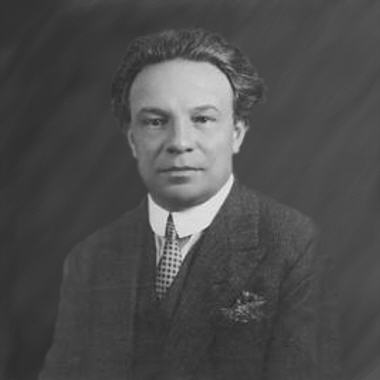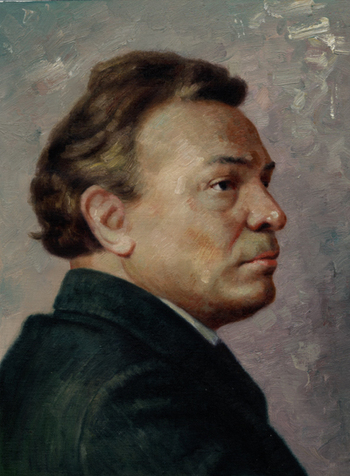<Back to Index>
- Inventor Elias Howe, Jr., 1819
- Composer Ottorino Respighi, 1879
- Holy Roman Emperor Ferdinand II, 1578
PAGE SPONSOR


Ottorino Respighi (July 9, 1879, Bologna - April 18, 1936) was an Italian composer, musicologist and conductor. He is best known for his orchestral Roman trilogy: Fontane di Roma - "Fountains of Rome"; Pini di Roma - "Pines of Rome"; and Feste Romane - "Roman Festivals". His musicological interest in 16th-, 17th- and 18th-century music led him to also compose pieces based on the music of this period.
Born in Bologna, he studied composition with Giuseppe Martucci and Nikolai Rimsky-Korsakov. Many sources indicate that he also studied briefly with Max Bruch, but in her biography of the composer, Respighi's wife asserts that this is not the case. Principally a violinist until 1908, he then turned primarily to composition. He lived in Rome from 1913. Ottorino Respighi was born in Bologna, Italy. He was taught piano and violin by his father, who was a local piano teacher. He continued studying violin and viola with Federico Sarti at the Liceo Musicale in Bologna, composition with Giuseppe Martucci, and historical studies with Luigi Torchi, a scholar of early music. A year after receiving his diploma in violin in 1899, Respighi went to Russia to be principal violist in the orchestra of the Russian Imperial Theatre in St Petersburg during its season of Italian opera; while there he studied composition for five months with Rimsky-Korsakov.
He then returned to Bologna, where he earned a second degree in
composition. Until 1908 his principal activity was as first violin in
the Mugellini Quintet.
In 1908 - 09 he spent some time performing in Germany before finally
returning to Italy and turning his attention entirely to composition. Upon being appointed a teacher of composition at the Conservatorio di Santa Cecilia in 1913, Respighi moved to Rome and lived there for the rest of his life. In 1919 he married a former pupil, singer Elsa Olivieri-Sangiacomo.
From 1923 to 1926 he was director of the Conservatorio. In 1925 he
collaborated with Sebastiano Arturo Luciani on an elementary textbook
entitled Orpheus. He was elected to the Royal Academy of Italy in 1932. A visit to Brazil resulted in the composition Brazilian Impressions.
Initially he intended to have a sequence of five pieces, but by 1928 he
had completed only three, and decided to present what he had. Its first
performance was in 1928 in Rio de Janeiro.
The first piece is a nocturne, "Tropical Night", with fragments of
dance rhythms suggested by the sensuous textures. The second piece is a
sinister picture of a snake research institute, Instituto Butantan, that Respighi visited in São Paulo, with hints of birdsong (as in The Pines of Rome). The final movement is a vigorous and colorful Brazilian dance. On the ship back home from Rio de Janeiro, Respighi met up by chance with Italian physicist Enrico Fermi.
During their long conversation Fermi tried to get Respighi to explain
music in terms of physics, which Respighi was unable to do.
Nonetheless, they remained close friends until Respighi's death in 1936. Respighi maintained an uneasy relationship with Benito Mussolini's National Fascist Party during his later years. He vouched for more outspoken critics such as Arturo Toscanini, allowing them to continue to work under the regime. Feste Romane, the third part of his Roman trilogy, was premiered by Toscanini and the New York Philharmonic Orchestra in 1929; Toscanini recorded the music twice for RCA Victor, first with the Philadelphia Orchestra in 1942 and then with the NBC Symphony Orchestra in 1949, and RCA released both versions, first on LP and then CD. Respighi's music had considerable success in the USA: the Toccata for piano and orchestra was premiered (with Respighi as soloist) under Willem Mengelberg with the New York Philharmonic Orchestra at Carnegie Hall in November 1928, and the large scale theme and variations entitled Metamorphoseon was a commission for the fiftieth anniversary of the Boston Symphony Orchestra. In his role as musicologist, Respighi was also an enthusiastic scholar of Italian music of the 16th -18th centuries. He published editions of the music of Claudio Monteverdi and Antonio Vivaldi, and of Benedetto Marcello's Didone.
Because of his devotion to these older figures and their styles of
composing, it is tempting to see him as a typical exponent of Neo-classicism. In fact, Neo-Renaissance or Neo-Baroque would
probably more accurately describe his compositions that are based on
earlier work. Respighi generally kept clear of the musical idiom of the classical period, unlike most neo-classical composers. He preferred combining pre-classical melodic styles and musical forms (like dance suites) with typical late 19th century romantic harmonies and textures. He
continued to compose and tour until January 1936, after which he became
increasingly ill. A cardiac infection led to his death by heart failure
on April 18 of that year at the age of 56. A year after his burial, his
remains were moved to his birthplace Bologna and reinterred at the
city's expense.